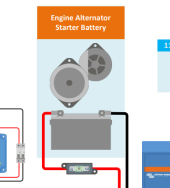bobsacimano
New Member
I am trying to find out if I need to "ground" my solar system in my van. For reference, I have a 12v 100w panel screwed and sealed to the roof of my van, a 100ah Lifepo4 battery, 20mppt rover charge controller and a 700w pure sine inverter that has GFCI outlets. All from renogy. According to the manuals, it says the inverter should be grounded to the vehicle. Is this neccessary given the small size of my system and the existing GFCI's? Also is any other "grounding" required? Like the battery as I've heard from some people as well. There seems to be a lot of conflicting information on this subject especially for a rookie like myself. I put "ground" in quotations because I know everyone would jump all over me about it never being a true ground in a vehicle. I've heard that already. Any help would be appreciated. Thanks in advance!!



